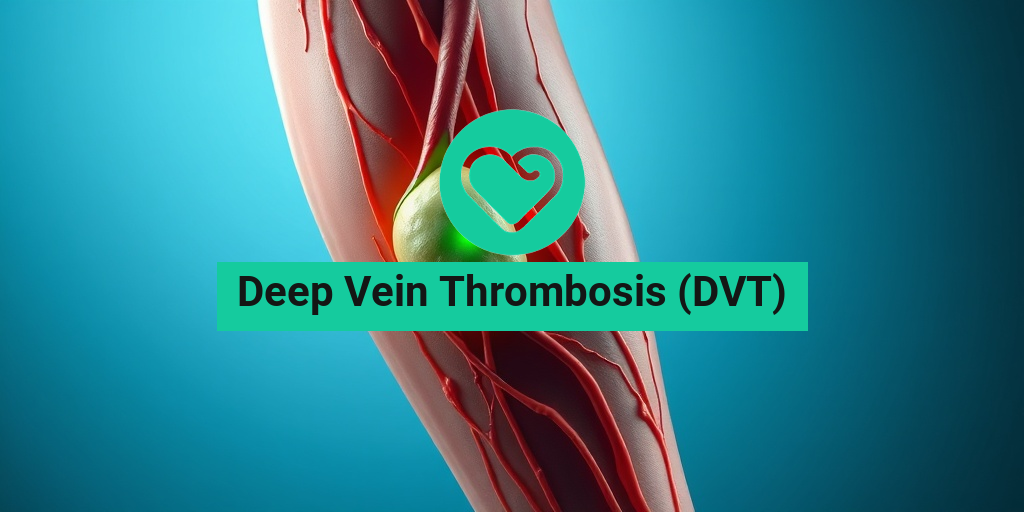What Is DVT?
Deep Vein Thrombosis (DVT) is a serious medical condition characterized by the formation of a blood clot in a deep vein, typically in the legs. This condition can lead to significant complications, including pulmonary embolism (PE), where the clot dislodges and travels to the lungs, potentially causing life-threatening consequences. Understanding DVT is crucial for prevention and timely treatment.
Causes of DVT
DVT can occur due to various factors, often related to prolonged periods of inactivity or certain medical conditions. Some common causes include:
- Prolonged Immobility: Sitting for long periods, such as during long flights or car rides, can slow blood flow and increase the risk of clot formation.
- Surgery: Major surgeries, especially those involving the legs or hips, can increase the risk of DVT due to reduced mobility during recovery.
- Medical Conditions: Conditions like cancer, heart disease, and certain genetic disorders can predispose individuals to DVT.
- Hormonal Factors: Hormonal changes, such as those caused by pregnancy, birth control pills, or hormone replacement therapy, can increase clotting risk.
Risk Factors
Several risk factors can elevate the likelihood of developing DVT, including:
- Age (risk increases with age)
- Obesity
- Smoking
- Family history of DVT or clotting disorders
Being aware of these risk factors can help individuals take proactive measures to reduce their chances of developing DVT.
DVT Symptoms
Recognizing the symptoms of DVT is vital for early diagnosis and treatment. While some individuals may experience no symptoms, others may notice the following:
Common Symptoms
- Swelling: One of the most noticeable signs of DVT is swelling in the affected leg, which may occur suddenly.
- Pain or Tenderness: Affected individuals may experience pain or tenderness in the leg, often described as a cramp or soreness.
- Red or Discolored Skin: The skin over the affected area may appear red or have a bluish tint.
- Warmth: The area around the clot may feel warmer than the surrounding skin.
When to Seek Medical Attention
If you experience any of these symptoms, especially if they occur suddenly, it is crucial to seek medical attention immediately. DVT can lead to serious complications, and timely intervention can save lives. If you suspect you have DVT, don’t hesitate to contact a healthcare professional.
Conclusion
Understanding Deep Vein Thrombosis (DVT) is essential for prevention and early detection. By being aware of the causes, risk factors, and symptoms, individuals can take proactive steps to protect their health. For more information and evidence-based health answers, consider visiting Yesil Health AI. Remember, your health is your wealth! 💖

DVT Risk Factors
Deep Vein Thrombosis (DVT) is a serious condition that can lead to significant health complications, including pulmonary embolism (PE). Understanding the risk factors associated with DVT is crucial for prevention and early detection. Here are some of the primary risk factors to consider:
1. Prolonged Immobility
One of the most significant risk factors for DVT is prolonged immobility. This can occur during long flights, extended car rides, or even during hospital stays. When blood flow is restricted due to lack of movement, the likelihood of clot formation increases. 🛫
2. Surgery and Trauma
Undergoing surgery, particularly orthopedic procedures like hip or knee replacements, can elevate the risk of DVT. Surgical trauma can damage blood vessels and lead to clot formation. Additionally, recovery periods often involve limited mobility, further compounding the risk.
3. Age
As we age, the risk of developing DVT increases. Individuals over the age of 60 are particularly susceptible due to changes in blood flow and vessel elasticity. It’s essential for older adults to be aware of their risk and take preventive measures.
4. Obesity
Excess body weight can put additional pressure on veins, particularly in the legs, making it harder for blood to flow back to the heart. This increased pressure can lead to clot formation. Maintaining a healthy weight is vital for reducing the risk of DVT.
5. Hormonal Factors
Hormonal changes, such as those experienced during pregnancy or while taking birth control pills, can increase the risk of DVT. These hormonal fluctuations can affect blood clotting mechanisms, making it easier for clots to form. Pregnant women should be particularly vigilant about their risk factors.
6. Family History
A family history of DVT or other clotting disorders can significantly increase your risk. Genetic factors can play a role in how your body regulates blood clotting, making it essential to discuss your family medical history with your healthcare provider.
7. Medical Conditions
Certain medical conditions, such as cancer, heart disease, and inflammatory bowel disease, can increase the risk of DVT. These conditions may affect blood flow or the body’s ability to regulate clotting, making it crucial for individuals with these conditions to be aware of their heightened risk.
DVT Causes
Understanding the causes of Deep Vein Thrombosis (DVT) is essential for effective prevention and management. DVT occurs when a blood clot forms in a deep vein, typically in the legs. Here are some of the primary causes:
1. Blood Flow Disruption
Any condition that disrupts normal blood flow can lead to DVT. This includes prolonged periods of immobility, as mentioned earlier. When blood flow slows down, it can pool in the veins, increasing the likelihood of clot formation.
2. Damage to Blood Vessels
Injuries or surgeries that damage blood vessels can trigger the clotting process. When the inner lining of a vein is injured, the body responds by forming a clot to prevent excessive bleeding. However, this clot can sometimes grow too large and obstruct blood flow, leading to DVT.
3. Increased Blood Coagulation
Some individuals have a genetic predisposition to increased blood coagulation, which can lead to DVT. Conditions such as Factor V Leiden mutation or antiphospholipid syndrome can cause the blood to clot more easily than normal, increasing the risk of DVT.
4. Hormonal Changes
As previously mentioned, hormonal changes can significantly impact the risk of DVT. For instance, pregnancy increases levels of certain clotting factors, which can lead to a higher risk of clot formation. Hormonal therapies, such as estrogen-based contraceptives, can also contribute to this risk.
5. Lifestyle Factors
Unhealthy lifestyle choices, such as smoking and a sedentary lifestyle, can increase the risk of DVT. Smoking damages blood vessels and affects circulation, while a lack of physical activity can lead to blood pooling in the veins. Making healthier lifestyle choices can help mitigate these risks. 🚭
6. Chronic Conditions
Chronic conditions like heart disease, diabetes, and cancer can also contribute to the development of DVT. These conditions may affect blood flow or the body’s ability to regulate clotting, making it essential for individuals with these conditions to be proactive in managing their health.
By understanding the risk factors and causes of Deep Vein Thrombosis (DVT), individuals can take proactive steps to reduce their risk and seek timely medical intervention when necessary. Awareness is key to prevention! 🩺

DVT Diagnosis
Diagnosing Deep Vein Thrombosis (DVT) is crucial for preventing serious complications, such as pulmonary embolism (PE). The process typically involves a combination of medical history evaluation, physical examination, and diagnostic tests.
Medical History and Symptoms
Your healthcare provider will start by asking about your medical history and any symptoms you may be experiencing. Common symptoms of DVT include:
- Swelling in one leg (or arm)
- Pain or tenderness, often described as a cramp or soreness
- Red or discolored skin over the affected area
- Warmth in the swollen area
It’s important to note that some individuals may not exhibit any symptoms, making it essential to be aware of risk factors such as prolonged immobility, recent surgery, or a history of blood clots.
Physical Examination
During the physical examination, your doctor will check for signs of swelling, tenderness, and changes in skin color. They may also assess your pulse and blood flow in the affected limb.
Diagnostic Tests
If DVT is suspected, your doctor may recommend one or more of the following diagnostic tests:
- Ultrasound: This is the most common test for diagnosing DVT. It uses sound waves to create images of the blood flow in your veins.
- D-dimer test: This blood test measures the presence of a substance that’s released when a blood clot breaks up. Elevated levels may indicate the presence of a clot.
- Venography: In this less common test, a contrast dye is injected into a large vein in your foot or ankle, making it visible on X-rays.
- CT or MRI scans: These imaging tests may be used in certain cases to provide detailed images of the veins.
Early diagnosis of DVT is vital for effective treatment and to reduce the risk of complications. If you suspect you have DVT, seek medical attention promptly! 🚑
DVT Treatment Options
Once diagnosed, the treatment for Deep Vein Thrombosis (DVT) aims to prevent the clot from growing, reduce the risk of PE, and alleviate symptoms. Treatment options may vary based on the severity of the condition and individual patient factors.
Anticoagulants
The primary treatment for DVT involves the use of anticoagulants, commonly known as blood thinners. These medications help prevent new clots from forming and stop existing clots from growing. Common anticoagulants include:
- Heparin: Often administered via injection, it works quickly to prevent clotting.
- Warfarin: An oral medication that requires regular blood tests to monitor its effect.
- Direct oral anticoagulants (DOACs): These newer medications, such as rivaroxaban and apixaban, do not require regular monitoring and are easier to manage.
Compression Stockings
In addition to anticoagulants, your doctor may recommend wearing compression stockings. These specially designed stockings help improve blood flow in the legs and reduce swelling. They can be particularly beneficial during recovery and may help prevent post-thrombotic syndrome, a condition that can occur after DVT.
Thrombectomy
In severe cases, especially when there is a high risk of PE, a procedure called thrombectomy may be performed. This involves surgically removing the clot from the vein. This option is typically reserved for patients with extensive clots or those who do not respond to anticoagulant therapy.
Inferior Vena Cava (IVC) Filter
For patients who cannot take anticoagulants due to bleeding risks, an IVC filter may be placed in the inferior vena cava (the large vein that carries blood from the lower body to the heart). This filter helps catch any clots before they can reach the lungs, reducing the risk of PE.
Lifestyle Changes and Prophylaxis
In addition to medical treatments, making certain lifestyle changes can help manage DVT and reduce the risk of recurrence. These may include:
- Staying active: Regular exercise can improve circulation.
- Avoiding prolonged immobility: Take breaks to move around during long periods of sitting or standing.
- Staying hydrated: Proper hydration can help maintain healthy blood flow.
Understanding your treatment options for DVT is essential for effective management and recovery. Always consult with your healthcare provider to determine the best course of action tailored to your specific needs. 🩺

DVT Prevention Strategies
Deep Vein Thrombosis (DVT) is a serious condition that can lead to significant health complications, including pulmonary embolism (PE). Understanding how to prevent DVT is crucial for maintaining your overall health, especially if you are at higher risk. Here are some effective strategies to help you reduce your chances of developing DVT:
1. Stay Active
Regular physical activity is one of the best ways to prevent DVT. Engaging in exercises that promote blood circulation can significantly lower your risk. Aim for at least 30 minutes of moderate exercise most days of the week. Activities such as walking, swimming, or cycling are excellent choices. 🏃♂️
2. Maintain a Healthy Weight
Being overweight can increase your risk of DVT. Maintaining a healthy weight through a balanced diet and regular exercise can help reduce this risk. Focus on consuming a diet rich in fruits, vegetables, whole grains, and lean proteins while limiting processed foods and sugars. 🍏🥦
3. Stay Hydrated
Dehydration can lead to thicker blood, increasing the risk of clot formation. Make sure to drink plenty of fluids, especially if you are traveling or spending long periods sitting. Aim for at least 8-10 glasses of water daily. 💧
4. Avoid Prolonged Sitting or Standing
If your job requires long periods of sitting or standing, take regular breaks to move around. Simple leg exercises, such as ankle pumps or calf raises, can help improve circulation. If you are traveling, try to stand up and walk around every hour. ✈️
5. Wear Compression Stockings
Compression stockings can help improve blood flow in your legs and reduce the risk of DVT, especially during long flights or car rides. Consult with your healthcare provider to find the right type and fit for your needs. 🧦
6. Follow Medical Advice
If you have a history of DVT or are at high risk due to surgery or other medical conditions, your doctor may recommend medications or other preventive measures. Always follow their advice and attend regular check-ups to monitor your health. 🩺
7. Be Aware of Risk Factors
Understanding your personal risk factors for DVT is essential. Factors such as age, family history, certain medical conditions, and lifestyle choices can all contribute to your risk. Being proactive about your health can help you make informed decisions. 📊
DVT Complications
While DVT can often be managed effectively, it is essential to be aware of the potential complications that can arise if the condition is left untreated. Here are some of the most significant complications associated with DVT:
1. Pulmonary Embolism (PE)
The most serious complication of DVT is pulmonary embolism, which occurs when a blood clot breaks loose and travels to the lungs. This can cause severe respiratory issues and can be life-threatening. Symptoms of PE may include sudden shortness of breath, chest pain, and coughing up blood. If you experience these symptoms, seek emergency medical attention immediately. 🚑
2. Post-Thrombotic Syndrome (PTS)
Post-thrombotic syndrome is a long-term complication that can occur after a DVT. It can lead to chronic pain, swelling, and skin changes in the affected leg. PTS can significantly impact your quality of life, making it essential to manage DVT effectively to reduce the risk of this syndrome. 🦵
3. Recurrence of DVT
Individuals who have had one episode of DVT are at a higher risk of experiencing another. This recurrence can lead to more severe complications and may require long-term management strategies, including anticoagulant therapy. Regular follow-ups with your healthcare provider are crucial for monitoring and prevention. 🔄
4. Skin Ulcers
Chronic venous insufficiency resulting from DVT can lead to skin ulcers, particularly around the ankles. These ulcers can be painful and difficult to heal, requiring specialized treatment. Maintaining good skin care and monitoring for any changes can help prevent these complications. 🩹
5. Emotional Impact
Living with DVT and its complications can take a toll on your mental health. Anxiety and depression are common among individuals dealing with chronic health issues. Seeking support from healthcare professionals, support groups, or mental health resources can be beneficial. 💔
Understanding the prevention strategies and potential complications of Deep Vein Thrombosis (DVT) is vital for maintaining your health and well-being. By taking proactive steps, you can significantly reduce your risk and manage any complications effectively.

Frequently Asked Questions about Deep Vein Thrombosis (DVT)
What is Deep Vein Thrombosis (DVT)?
Deep Vein Thrombosis (DVT) is a medical condition characterized by the formation of a blood clot in a deep vein, usually in the legs. This condition can lead to serious complications if not treated promptly.
What are the common causes of DVT?
Several factors can contribute to the development of Deep Vein Thrombosis (DVT), including:
- Prolonged immobility (e.g., long flights or bed rest)
- Injury to a vein
- Certain medical conditions (e.g., cancer, heart disease)
- Hormonal changes (e.g., pregnancy, birth control pills)
- Genetic predisposition to clotting disorders
What are the signs and symptoms of DVT?
Individuals with Deep Vein Thrombosis (DVT) may experience:
- Swelling in one leg
- Pain or tenderness in the affected area
- Warmth in the skin over the affected vein
- Red or discolored skin
How is DVT diagnosed?
Diagnosis of Deep Vein Thrombosis (DVT) typically involves:
- Physical examination by a healthcare provider
- Ultrasound imaging to visualize blood flow
- Blood tests to check for clotting disorders
What are the treatment options for DVT?
Treatment for Deep Vein Thrombosis (DVT) may include:
- Anticoagulant medications to prevent further clotting
- Compression stockings to reduce swelling
- In some cases, procedures to remove the clot
Can DVT lead to pulmonary embolism (PE)?
Yes, Deep Vein Thrombosis (DVT) can lead to a serious condition known as pulmonary embolism (PE), where a blood clot travels to the lungs, potentially causing severe complications or even death. It is crucial to seek medical attention if you suspect DVT.
What preventive measures can be taken against DVT?
To reduce the risk of developing Deep Vein Thrombosis (DVT), consider the following:
- Stay active and avoid prolonged periods of immobility
- Wear compression stockings during long travels
- Stay hydrated and maintain a healthy weight
- Consult your doctor about medications if you are at high risk
Is DVT a serious condition?
Yes, Deep Vein Thrombosis (DVT) is considered a serious condition due to the risk of complications such as pulmonary embolism. Early diagnosis and treatment are essential for a positive outcome.
When should I seek medical help?
If you experience symptoms such as swelling, pain, or warmth in your leg, it is important to seek medical help immediately. Early intervention can significantly reduce the risk of complications associated with Deep Vein Thrombosis (DVT).




